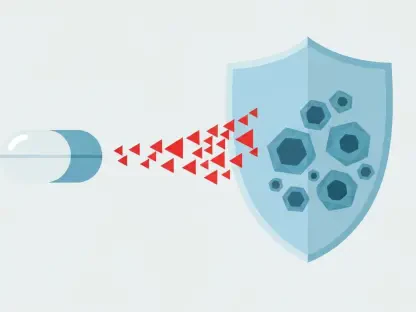I’m thrilled to sit down with Ivan Kairatov, a renowned biopharma expert with a wealth of experience in research and development, particularly in the realm of innovative technologies shaping the industry. Today, we’re diving into the groundbreaking work surrounding vaccine development for Helicobacter pylori, a bacterium linked to stomach ulcers and cancer. Our conversation explores the challenges of combating this pervasive pathogen, the cutting-edge methods being used to design potential vaccines, and the transformative impact such a breakthrough could have on global health.
Can you start by telling us what Helicobacter pylori is and why it poses such a significant threat to stomach health?
Absolutely. Helicobacter pylori is a type of bacterium that infects the stomach lining and is incredibly common—over 60% of the global population carries it. What makes it a big deal is its role in causing most stomach ulcers, which were once blamed on diet or stress. Beyond ulcers, it significantly raises the risk of stomach cancer, one of the deadlier forms of the disease. It thrives in the harsh acidic environment of the stomach, often without symptoms, which means many people don’t even know they’re infected until serious damage occurs.
What drives the urgency to develop a vaccine against H. pylori, and how did this become a focus for research teams like yours?
The urgency comes from the sheer scale of the problem. With such a high infection rate, especially in developing regions, and the link to life-threatening conditions like cancer, a preventive solution like a vaccine could be a game-changer. For many researchers, including myself, the motivation stems from seeing the limitations of current treatments—antibiotics often fail due to resistance, and they don’t prevent reinfection. The idea of a vaccine emerged as a way to tackle the root cause, and it’s been inspiring to see teams globally, including academic groups, rally around this challenge with fresh perspectives and innovative tools.
Can you explain the innovative approach of immunoinformatics and how it’s being applied to find a vaccine for H. pylori?
Sure, immunoinformatics is essentially a marriage of computer science and immunology. It allows us to analyze the genetic blueprint of pathogens like H. pylori using powerful algorithms to predict which components—specifically proteins or parts of proteins—might trigger a strong immune response. Instead of spending years in a lab testing countless possibilities, we can simulate thousands of scenarios computationally. This speeds up the process dramatically and cuts costs, helping us zero in on the most promising vaccine targets before moving to physical experiments.
Through these simulations, what have you learned about how H. pylori survives and evades the immune system?
One of the fascinating findings is how cunning H. pylori is. It produces specific proteins that help it cling to the stomach lining, withstand the extreme acidity, and dodge the body’s immune defenses. These proteins act like a shield, preventing immune cells from effectively attacking the bacterium. By mapping out these mechanisms through simulations, we’ve been able to identify critical weak points in the bacterium’s armor—areas we can target to disrupt its survival strategy and make it vulnerable to the immune system.
You’ve identified parts of these proteins that could stimulate a protective immune response. What makes these components so promising for a vaccine?
What’s exciting is that these protein fragments, or epitopes, appear to be highly immunogenic—meaning they can provoke a robust reaction from the immune system to fight off the bacterium. They’re also predicted to be safe, with a low likelihood of triggering allergic reactions or other adverse effects. Essentially, these components could train the body to recognize and attack H. pylori before it causes harm, which is the cornerstone of an effective vaccine. It’s like giving the immune system a detailed wanted poster for the pathogen.
Since your current work relies on computer models, what are the next steps to bring these findings into the real world?
The next phase is all about validation. We need to move from digital predictions to hands-on lab experiments, testing these protein fragments in controlled settings to see if they indeed trigger the expected immune response. This involves working with cell cultures and animal models to assess both efficacy and safety. It’s a meticulous process—every prediction must be confirmed through biological assays. While timelines vary, this stage could take a few years before we’re ready for human trials, assuming all goes well.
Given that there’s no approved vaccine for H. pylori despite global efforts, what do you think are the biggest hurdles in this field?
Developing a vaccine for H. pylori is uniquely challenging. For one, the bacterium’s ability to hide from the immune system makes it a tough target—standard vaccine strategies often fall short. Additionally, its location in the stomach means a vaccine must stimulate immunity in a very specific way, often requiring novel delivery methods or adjuvants to boost the response. There’s also the issue of strain diversity across regions, which complicates a one-size-fits-all solution. Progress has been slow globally due to these hurdles, but each team’s unique angle—like leveraging computational tools—brings us closer to cracking this puzzle.
If a vaccine for H. pylori becomes a reality, how do you envision it impacting people’s lives around the world?
The impact could be profound. A vaccine would offer a way to prevent stomach ulcers and reduce stomach cancer rates, especially in high-risk areas where infection is nearly universal. It could lessen the reliance on antibiotics, curbing the growing problem of resistance, and save countless lives by addressing the issue before symptoms even appear. Beyond health, it would ease the economic burden of treating chronic conditions linked to H. pylori, particularly in resource-limited settings. It’s hard to overstate how transformative this could be for global public health.
Looking ahead, what is your forecast for the future of vaccine development against H. pylori and similar tough pathogens?
I’m cautiously optimistic. The integration of technologies like immunoinformatics is revolutionizing how we approach vaccine development, not just for H. pylori but for other elusive pathogens as well. I believe we’re on the cusp of breakthroughs, especially as computational power and biological understanding continue to advance. In the next decade, I expect we’ll see more tailored vaccines—ones designed for specific populations or strains—become a reality. Collaboration across disciplines and borders will be key, and I think we’ll look back on this era as a turning point in how we outsmart some of nature’s trickiest microbes.









